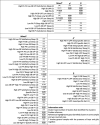Clusters of 24-hour movement behavior and diet and their relationship with health indicators among youth: a systematic review
- PMID: 38637757
- PMCID: PMC11027390
- DOI: 10.1186/s12889-024-18364-6
Clusters of 24-hour movement behavior and diet and their relationship with health indicators among youth: a systematic review
Abstract
Movement-related behaviors (physical activity [PA], sedentary behavior [SB], and sleep) and diet interact with each other and play important roles in health indicators in youth. This systematic review aimed to investigate how PA, SB, sleep, and diet cluster in youth by biological sex; and to examine which cluster are associated with health indicators. This study was registered in PROSPERO (number: CRD42018094826). Five electronic databases were assessed. Eligibility criteria allowed studies that included youth (aged 19 years and younger), and only the four behaviors {PA, SB, sleep, and diet (ultra-processed foods [UPF]; fruits and vegetables [FV])} analyzed by applying data-based cluster procedures. From 12,719 articles screened; 23 were included. Of these, four investigated children, and ten identified clusters by biological sex. Sixty-six mixed cluster were identified including, 34 in mixed-sex samples, 10 in boys and 11 in girls. The most frequent clusters in mixed-sex samples were "High SB UPF Low Sleep", "Low PA High SB Satisfactory Sleep", and "High PA". The main difference in profiles according to sex was that girls' clusters were characterized by high sleep duration, whereas boys' clusters by high PA. There were a few associations found between cluster types and health indicators, highlighting that youth assigned to cluster types with low PA exhibited higher adiposity. In conclusion, the youth presented a range of clusters of behaviors, typically exhibiting at least one unhealthy behavior. Similar patterns were observed in both sexes with the biggest difference in time of sleep for girls and PA for boys. These findings underscore the importance of intervention strategies targeting multiple behaviors simultaneously to enhance health risk profiles and indicators in children and adolescents.
Keywords: Adolescent health; Child Health; Clustering; Diet; Exercise; Food and Nutrition; Sleep.
© 2024. The Author(s).
Conflict of interest statement
The authors declare no competing interests.
Figures



Similar articles
-
A systematic review of the clustering and correlates of physical activity and sedentary behavior among boys and girls.BMC Public Health. 2023 Feb 21;23(1):372. doi: 10.1186/s12889-022-14869-0. BMC Public Health. 2023. PMID: 36810023 Free PMC article.
-
Clustering of diet, physical activity and sedentary behaviour and related physical and mental health outcomes: a systematic review.BMC Public Health. 2023 Aug 18;23(1):1572. doi: 10.1186/s12889-023-16372-6. BMC Public Health. 2023. PMID: 37596591 Free PMC article.
-
Association between Physical Activity, Sedentary Behaviors, Sleep, Diet, and Adiposity among Children and Adolescents in China.Obes Facts. 2022;15(1):26-35. doi: 10.1159/000519268. Epub 2021 Nov 16. Obes Facts. 2022. PMID: 34784593 Free PMC article.
-
Clustering of Physical Activity, Diet and Sedentary Behavior among Youth from Low-, Middle-, and High-Income Countries: A Scoping Review.Int J Environ Res Public Health. 2021 Oct 17;18(20):10924. doi: 10.3390/ijerph182010924. Int J Environ Res Public Health. 2021. PMID: 34682670 Free PMC article.
-
The clustering of diet, physical activity and sedentary behavior in children and adolescents: a review.Int J Behav Nutr Phys Act. 2014 Jan 22;11:4. doi: 10.1186/1479-5868-11-4. Int J Behav Nutr Phys Act. 2014. PMID: 24450617 Free PMC article. Review.
Cited by
-
Diet, Activity and Sleep Clusters Associated With Obesity Markers of Children in the US-Affiliated Pacific.Acta Paediatr. 2025 Jul;114(7):1642-1652. doi: 10.1111/apa.70012. Epub 2025 Feb 24. Acta Paediatr. 2025. PMID: 39989394 Free PMC article. Clinical Trial.
-
Healthier Diet and Diet-Related Behaviors Are Associated with Increased Physical Activity and Reduced Sedentary Behavior Among Adolescents in Greece.Nutrients. 2025 Jan 21;17(3):381. doi: 10.3390/nu17030381. Nutrients. 2025. PMID: 39940239 Free PMC article.
-
Transitions of 24-H Movement Behaviour Profiles From Schooldays to Weekends and Their Associations With Health-Related Quality of Life and Well-Being in Czech Adolescents.Child Care Health Dev. 2025 Jul;51(4):e70121. doi: 10.1111/cch.70121. Child Care Health Dev. 2025. PMID: 40576241 Free PMC article.
-
Considering the 24-Hour Activity Cycle in Older Adults.Am J Lifestyle Med. 2024 Oct 7:15598276241288102. doi: 10.1177/15598276241288102. Online ahead of print. Am J Lifestyle Med. 2024. PMID: 39540175 Free PMC article. Review.
-
Mapping Evidence on Integrated 24-Hour Movement Behaviors in Children and Adolescents: A Scoping Review of Reviews.Children (Basel). 2025 Feb 20;12(3):260. doi: 10.3390/children12030260. Children (Basel). 2025. PMID: 40150543 Free PMC article. Review.
References
Publication types
MeSH terms
LinkOut - more resources
Full Text Sources
Medical

